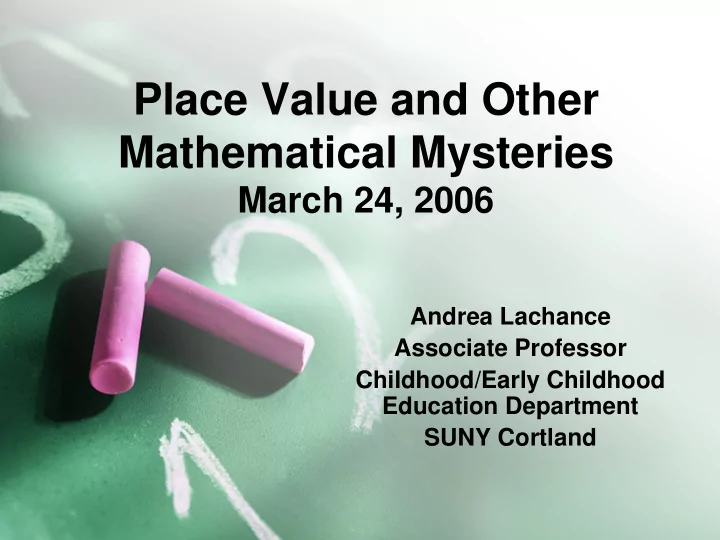

Place Value and Other Mathematical Mysteries March 24, 2006 Andrea Lachance Associate Professor Childhood/Early Childhood Education Department SUNY Cortland
Problem of the Day: The Place Value Game • Sylvia has the following cards: 49298 83483 43281 If Ms. Descartes pulls a 3, how many points will Sylvia have? • What digit does she hope Ms. Descartes will pull next week so that she will have the highest possible score?
Extra • Sylvia's friend Carina has these cards: 89378 42327 49734 • What's one digit that Ms. Descartes could pull next week that would give Carina a higher score than Sylvia? (Remember that both Sylvia and Carina have to compare scores using the number Ms. Descartes draws.)
Procedural vs. Conceptual Understandings • Procedural Knowledge: Based on a series of actions involving rules and algorithms. • Conceptual Knowledge: Based on connected networks which help us link ideas and see relationships.
Place Value: Procedural Knowledge Connecting numbers to their appropriate places: – The tens place is the second place to the right. – In the number, 235, 2 is in the hundreds place
Place Value: Conceptual Knowledge • Understanding the relationship between each place (10 times the one next to its left). • Understanding the components of a number: 235 = 200 + 30 + 5 or 2 hundreds + 3 tens + 5 ones
General Process for Developing the Meaning of Mathematical Ideas • Concrete: Start with concrete situations. Use manipulatives to illustrate or act out a situation. • Semiconcrete: Representing situations with pictures, diagrams, etc. • Abstract: Representing situations with symbols (particularly numeric symbols).
Learning a New Number System: Counting • Select a partner. • Count out 30 objects • Partner 1: Recorder - Number a piece of paper from 1 to 30. • Partner 2: Counter - Move the objects from the uncounted pile to the counted pile as we count them.
Learning a New Number System: Place Value • What number is our new number system based upon? • How many digits in this system? • Give the names of the first three “places” for this system. • How are these places related to each other?
Learning a New Number System: Manipulatives • Sort the place value blocks into groups by size. • Which block represents which place? • Using your place value mats, represent the following numbers with your blocks: 24 103 231 430
Learning a New Number System: Adding Using whatever methods you choose, practice adding in the new number system by completing these problems: 12 + 11 = 14 + 34 = 24 + 232 = 133 + 324 =
Learning a New Number System: Subtracting Using whatever methods you choose, practice adding in the new number system by completing these problems: 33 - 12 = 41 - 14 = 123 - 44 = 321 - 132 =
Reflecting on Our New Knowledge • How did you feel as you were learning this new number system? • What helped you to understand the new number system? • How is this number system related to our own number system?
Moving from Counting to Place Value • Build upon counting experiences • Move to counting by groups • Practice equivalent grouping (regrouping) • Reinforce counting by groups with oral names (standard and place value) and written names.
A Transitional Game: Race to 100 • Work with a partner. • Each partner takes turns rolling a dice. • Whatever number you get on the dice, you take that many objects. • When you get ten of an object, you trade in for a ten. • The first person to 100 wins!
Models for Place Value • Groupable - Grouped by learner. • Pregrouped/Trading - Base 10 blocks • Proportional - 10 is ten times bigger than 1. • Non-Proporational - More abstract; money, chip trading, etc. • 0-99 chart and place value chart
Resources • Problems of the week: Mathforum.org • Games: Race to 100, I am the Greatest • Connections to Operations: Digits Game and Multiplication Challenge. • Use with the calculator and computer
Contact: Andrea Lachance Childhood/Early Childhood Education Department - SUNY Cortland P.O. Box 2000 Cortland, NY 13045-0900 Tel: 607-753-5528 Email: lachance@cortland.edu
Recommend
More recommend